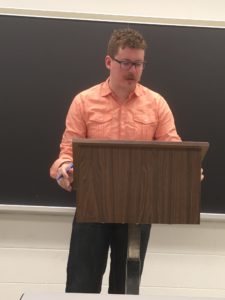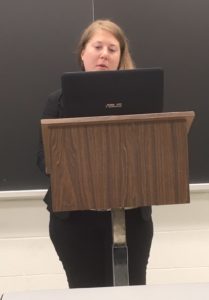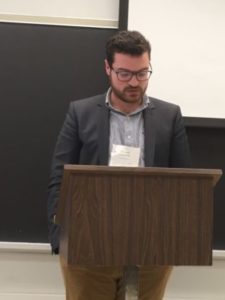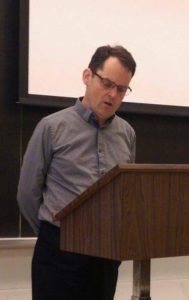2017 CSBS Christian Apocrypha Session Report
Last weekend (May 27-29) I attended the Annual Meeting of the Canadian Society of Biblical Studies at Ryerson University in Toronto. For several years now I have organized an ad hoc Christian apocrypha panel—essentially, if enough papers are submitted, I cajole the program director to put them all together into one session. This year we had four papers, and these were paired with two papers that did not fit into other sessions.

The first presentation was by University of Toronto student Ian Phillip Brown: “Where Indeed was the Gospel of Thomas Written?: Thomas as a Product of Alexandrian Intellectual Culture.” Brown argued against the notion that Gos. Thom. was composed in Edessa, a position dominant in discussions of the text, indeed to the point that some scholars romanticize a “school of Thomas” situated in Syria. This idea has spilled over also to the Infancy Gospel of Thomas, leading early scholars of the text to assume it too was composed in Syria, and even posit a Syriac origin to the text (a view that I have taken great pains to refute). But, as Brown said, the popularity of a text in a given area is not proof for origin, nor should later texts, in this case the Acts of Thomas, be used to date and situate earlier texts. Brown considers Alexandria a much more likely location for the writing of Thomas as it fits in well with the Jewish exegetical traditions of Genesis practiced there by Philo and others. Brown took time also to note arguments for the presence of Semitisms in the text and Simon Gathercole’s efforts to show that this phenomenon can be explained without recourse to a Syriac or Aramaic original. The conversation after Brown’s paper was lively. He was asked how origin in Alexandria affected source critical arguments for the text—e.g., its (perhaps) early origins, its relationship to Tatian, etc. Another question came up about how to interpret the esteem held for James in logion 12, which some scholars have seen as evidence for an early Jewish-Christian stratum for the text. I mentioned also that our earliest physical evidence for Gos. Thom. is the Greek fragments from Oxyrhynchus and the earliest testimonies are from writers in Alexandria (Clement and Origen).

The second presentation came from another student at the University of Toronto, Amelia Porter, with her paper “New Paideia?: The Construction of Social Identity in the Infancy Gospel of Thomas.” Porter’s supervisor, John Kloppenborg, had mentioned Porter to me a few days earlier because of my work on the text, and likely I will be added to her supervisory committee. Porter’s paper focused on the three teacher stories in the text. She sees these as efforts to replace Roman paideia (which, Porter argued, is not just learning to read and write, but also the acquisition of Roman culture) with a Christian paideia, where knowledge of Jesus is considered superior to all other learning. This is observable in the first teacher story (ch. 6), in which Zacchaeus seeks to teach the unruly child, “so that he may learn to love those his own age, honour old age and revere elders, so that he may acquire a desire to be among children, also teaching them in return” (6:2). The teaching begins with the alphabet, but Jesus refuses to repeat it back to the teacher, and instead instructs Zacchaeus on the esoteric qualities of the Alpha. Zacchaeus is humbled by this display of knowledge. A second teacher (ch. 14) is killed by Jesus after striking Jesus on the head for refusing to repeat the alphabet to him. And finally, in the third story (ch. 15), another teacher worships Jesus after witnessing him open a book and, instead of reading from it, he speaks “in the spirit.” Porter concluded that the gospel’s teacher episodes “illustrate a move by Roman/Gentile Christians toward separation and differentiation from the reigning cultural paradigm. In its place, IGT is constructing an identity based on access to ‘true’ knowledge, embodied in the text by the child Jesus, and illustrated via his superiority to both the teachers of the ‘old school’ and the cultural systems they represent.” There was little time for discussion after the paper, but Porter and I spoke at the break and I made a few suggestions to her. First, in the text, Jesus naturally is taught by Jewish teachers, and Jacob Neusner, perhaps the first scholar to look seriously at these stories for what they might say about the text’s origins, suggested that Jesus is shown here to be superior to Jewish, not Roman culture, specifically the rabbinic school being formulated by Zacchaeus’s namesake Johanan ben Zakkai around the same time as Inf. Gos. Thom.’s composition. Mind you, it is unlikely that the gospel’s writer and readers are Jewish, and Jesus’ conflict with Jewish learning can work just as effectively as an analogy for Roman or Greek culture, but the thoughtworld of the text should be acknowledged. I also suggested she broaden the narrative ark of the teacher stories to include the gospel’s climax in the story of Jesus in the temple borrowed from Luke; hereJesus amazes the teachers with his knowledge of “the main points of the law and the riddles and the parables of the prophets.” Of course, here Jesus is shown as having mastered Jewish learning, not rejected it.
The next two papers in the session—Robert Revington (McMaster University), “Name Repetition in Narrative Units in the New Testament and Other Literature” and Chiaen (Joshua) Liu (McMaster Divinity College), “Peter’s Sermon on Christological Prophecy: A Register Analysis on Acts 3:12-26”—did not examine apocryphal texts, so I will not comment on them, except to say that the pop culture references in Revington’s presentation would have put Mark Goodacre to shame (the best was his mention of the two Marthas of Superman v. Batman).

We returned to Christian apocrypha with Robert Edwards’ (University of Notre Dame) paper “The Deposition and Christology in the Gospel of Peter.” Edwards challenged the common assessment of Gos. Pet.’s Christology as “unsophisticated” in relation to the canonical Gospels, a rather unfair characterization given that we only have a few fragments of the text. For some time, scholars tried to find evidence of docetic Christology in the text, a search occasioned by Eusebius’ discussion of its use among docetics in the church of Serapion. Scholars eventually abandoned that view but have not replaced it with anything else. Edwards looked at the deposition account in the gospel, a section mostly without parallel in the NT Gospels, and noted some interesting features: the earthquake occurs when Jesus is placed on the ground (affirming the sacredness of Jesus’ body, Edwards said, rather than an eschatological event as in Matthew), Jesus is called “Lord” throughout the text, even after his death (the NT Gospels tend to have “Jesus’ body”), and the giant Jesus who exits the tomb, with his head stretching to heaven, forms a bridge between heaven and earth, the spiritual and the physical. All of these phenomena suggest to Edwards that Gos. Pet. affirms the materiality of Jesus, with his body and soul united throughout the text. In the discussion that followed, questions were asked about the meaning of Jesus’ final words (“My power, my power, you have forsaken me”) and the possible connection between the two figures who take Jesus out of the tomb with Moses and Elijah from the Transfiguration scene.

The final paper in the session was mine: “Christian Apocrypha in Ancient Libraries.” This paper was supposed to be presented at the 2009 SBL Annual Meeting. François Bovon, well-known for his scholarship on the Christian apocrypha, was slated to offer a response. As it turned out, I had to cancel my appearance at SBL that year when my father was diagnosed with terminal cancer. François too died of cancer just a few years ago. I was asked to contribute something to a memorial volume for François and thought it would be appropriate to resurrect this paper and finish it at last. The idea of discovering lost Christian gospels in a musty old library is a familiar motif, found often in fiction, film, and in the discovery stories of modern forgeries; the discovery site ranges from the vaults of the Vatican, to a remote monastery, to a cave; of course, there is good reason to use this motif—we do often find lost and forgotten apocrypha in such locations. Apocrypha were present in ancient libraries also; the evidence indicates that they sat upon shelves near or next to canonical texts and non-Christian literature; this goes against the common notion that once banned in the canon selection process, apocryphal texts were cast aside, or destroyed; but where else would heresy hunters get the source material they needed for their polemics, and how would church councils know which texts to ban and which writers to anethamatize? The paper draws together the evidence of apocrypha in ancient libraries from the church writers of the first four centuries, from caches of codices discovered in Egypt, and from references to libraries in apocryphal texts, to see what we can learn about how apocrypha were read, stored, and exchanged in the early Christian library network as it developed just prior to and shortly after the Christian triumph brought by Constantine the Great. Along the way I look at works used in Alexandria by Clement, Origen, and Didymus the Blind, in Caesarea by Eusebius, in Jerusalem by Jerome and Epiphanius, in Rome by Hippolytus, and texts believed to have come from Pachomian monasteries (the Nag Hammadi Codices, the Dishna papers, and the Chester Beatty Papyri). It is a sweeping paper sorely in need of reduction to a manageable size—even the presentation version of it went a little long despite a fast-paced read. But in the five minutes of discussion that followed I received some very useful feedback that will improve the paper considerably (including taking a look at Lucian’s Ignorant Book Collector, adding some nuance to my discussion of private vs. public libraries, and considering the mischievous appeal of owning banned books, even for orthodox writers).
And that brings another CSBS Christian apocrypha session to a close. If you are interested in presenting a paper next year, please get in contact with me. The CSBS is a relatively small gathering (around 80 papers presented on average), but its size is its strength. Participants routinely praise it as much for its cordiality as the quality of the work presented. This is Canada, after all.

I am flattered to have been compared with Goodacre, even if it is for the use of pop culture references! It was a great panel.